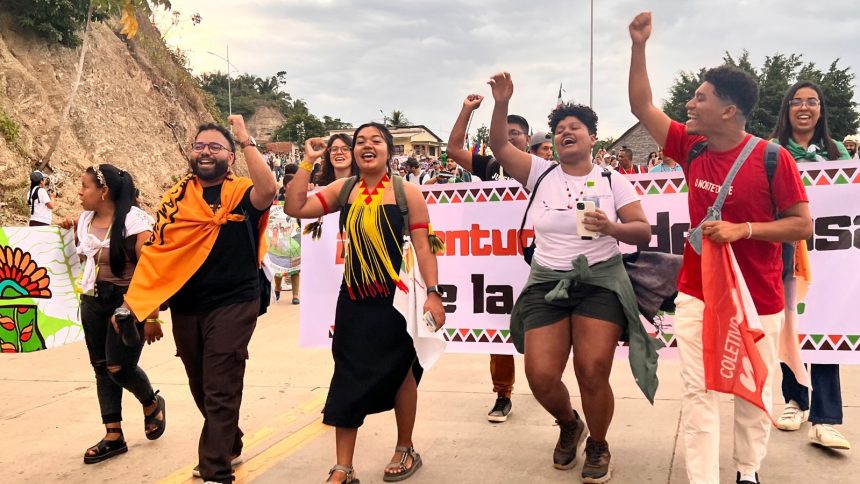This story was originally published by Inside Climate News and is reproduced here as part of the Climate Desk collaboration.
Beneath a setting sun, marchers clad in feathered headdresses and hand-woven clothing streamed across the Alto Beni River bridge on a muggy June evening, calling out: “Agua si! Minería no!” “Viva Amazonia!”
The march marked the opening of a four-day gathering known as the Pan-Amazon Social Forum (FOSPA), a semi-annual incubator where activists and leaders from Indigenous, Afro-descendant and other land-based communities exchange ideas for defending nature and the people of the Amazon rainforest. Attendees, young and old, brown, Black and white, chanting “Water, yes! Mining no!” clasped signs representing dozens of organizations and causes, from “Women in the Northern Amazon” to “Nunca Más Un Mundo Sin Nosotros,” or Never Again a World Without Us.
For the 1,400 who descended on this small, bucolic Amazonian town, most of whom hail from Indigenous and other local communities across the nine Amazonian countries—Brazil, Peru, Colombia, Venezuela, Ecuador, Bolivia, Guyana, Suriname, and French Guiana—the meeting was a welcome change from the formal United Nations’ Conference of the Parties (COPs). COPs on climate change and biodiversity, which are dominated by government delegations, have been criticized for being captured by industry lobbyists.
“FOSPA is one of the few spaces for us to have our own dialogues,” said Vanuza Abacatal, the leader of a 314-year-old Quilombola community in Pará, Brazil. Abacatal’s community has struggled to defend its autonomy and maintain its way of life in the face of an encroaching agricultural frontier, mining, and deforestation.
Beyond feeling that international negotiations are disconnected from their lives, the marchers here in Rurrenabaque and San Buenaventura, the small Bolivian towns hosting the conference, say governmental climate talks have failed. They cite the Paris Agreement’s target to limit global warming to 1.5 degrees Celsius above pre-industrial levels. In 2023, global average temperatures breached 1.5 C for 12 months in a row, the European climate service Copernicus announced in February, and the world’s current warming trajectory will put global temperature rise at 2.8 degrees Celsius by 2100. Scientists say that amount of warming will be disastrous for the Amazon. Current levels of warming are already changing the forest’s hydrological cycles, drying it out, and making it more susceptible to fire. As more forest is lost, more carbon dioxide is released into the atmosphere, worsening global warming in a reinforcing cycle.
Climate change is just one of several human-driven forces that has, over the last century, caused about 20 percent of the Amazon to be lost and an even larger portion to be degraded. Agriculture, cattle rearing, mining, oil extraction, and logging are all contributing factors. Loss of the Amazon, which is happening at a pace of roughly four soccer fields per minute, has already reached a point where some portions of the forest can no longer regenerate and have become grasslands. Directly affected are 47 million people living in the Amazon region who depend on the forest for their livelihoods, fresh water, and other resources.
The marchers here at FOSPA are witnessing the Amazon’s destruction firsthand. “We are being suffocated by large enterprises,” Abacatal said.
She and other Amazonian inhabitants are simultaneously the most impacted by the loss of the forest and, they have long argued, best positioned to safeguard what remains of it. Their peoples’ centuries of experience living within the forest have endowed them with valuable knowledge about it. Research is quickly catching up to them, with study after study confirming that Indigenous communities with secure land tenure have the best conservation outcomes, even when located near urban areas. And, increasingly, scientists are partnering with some Indigenous and local communities to identify key biodiversity hotspots and prioritize those areas, like animal reproduction and migration zones, for conservation.
With those bona fides, participants said they are ramping up their ambitions since the last FOSPA, held in 2022 in Belem, Brazil. That conference, like the nine before it dating to 2002, generated an accounting of the threats facing the forest and called on governments to do more to protect it.
But in the intervening two years since Belem, millions of acres of the Amazon have been cleared, burned, or degraded; threats to inhabitants like mining and drug trafficking grew; and governmental talks in a separate conference in Belem in 2023 among the leaders of the nine Amazonian nations concluded without an agreement on stopping illegal deforestation by 2030. Instead, that Brazil-led summit ended with a vague text promising to cooperate on staunching illegal deforestation and promoting sustainable development.
So, with the stakes as high as ever, FOSPA attendees in Rurrenabaque had a deadline in sight: Within four days, they had to deliver a written prescription for what the world must do to prevent “climate and ecological collapse.”
‘Original people without our land are nothing’ On the second day of the conference, in an Indigenous community outside Rurrenabaque, dozens of people focused their attention on Mari Luz and Emilsen Flores, Peruvian Kukama leaders. They were gathered inside a rainforest pavilion where nearly everyone had broken out into a sweat in the tropical heat. The pavilion had been set up with white plastic chairs, though some local men remained standing outside, their heads poking over the structure’s walls. Luz, speaking in a gentle voice, unspooled how she, Flores, and other Kukama women won a historic Peruvian court ruling in March, establishing that the heavily polluted Marañon River is a living being with inherent rights.
It was a major victory in the rights of nature movement, which aims to garner legal recognition of the rights of rivers, forests, and whole ecosystems to exist. The movement is largely seen as translating into law the worldviews of Indigenous peoples.
As Luz spoke, glasses of fresh papaya juice and chicha, a customary drink made from fermented corn, were passed around to the mix of conference attendees and Tacana people from the host community, Bella Altura.
She began in 2000, when environmental organizations from Europe came to meet with locals about the vast oil-related pollution in the Loreto region of Peru, which had been ongoing since 1974. For Luz and the others, who depended on the Marañon River for food, water, and transportation, the contamination had been catastrophic.
During the male-dominated meetings, Luz and other women had sat quietly, she explained, listening to the discussion about human rights. But later, the women met amongst themselves to discuss what they had heard. Luz recalled: “We women said, ‘We’re supposed to have rights. How can oil projects be forced on us when we don’t want them?’”
The women quietly formed their own federation, the Huaynakana Kamatahuara kana, meaning “working women,” she said, with the aim of protecting their environment, rights, and culture. And then, in what would prove to be a propitious encounter, Luz was introduced to environmental lawyers at the Peru-based Institute of Legal Defense. She wanted to know whether the Marañon River, like her, had rights. “Do rivers have rights?” reads an illustration depicting the story of the Peruvian Kukama women who won a landmark victory in March establishing that the heavily polluted Marañon River is a living being with inherent rights.
A dialogue ensued, with Luz educating the lawyers about her peoples’ view of the world. Nature is alive, she told them, and every being has a spirit. Those spirits live in the mountains and beneath the river, maintaining all the life within it.
The lawyers, in turn, told Luz and the Kukama women’s federation about the burgeoning body of law known as the “rights of nature.”
Thus began a 10-year partnership that culminated four months ago in a trial court ruling in favor of the Marañon River’s rights. Luz was blunt about the difficulties throughout. She and her family had been threatened with violence. “To be famous is very dangerous,” she said. To attend court hearings, she had to leave her rural home in the middle of the night, traveling by motorized canoe for hours, often in drenching rain.






